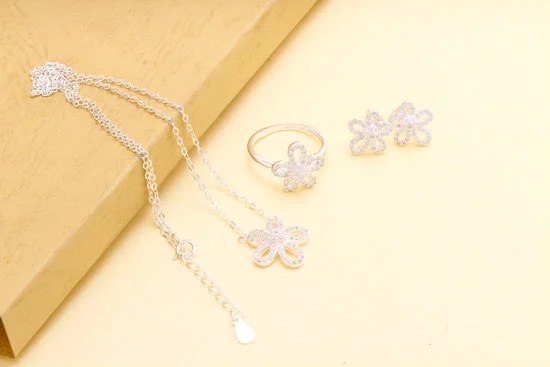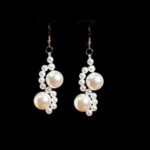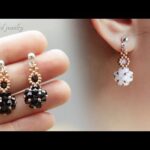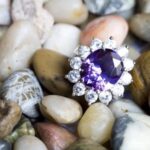Diamonds have always held a special allure, captivating us with their brilliance and elegance. From engagement rings to heirloom pieces, jewelry adorned with diamonds symbolizes love, prestige, and sophistication. However, the diamond industry is not immune to counterfeit gems infiltrating the market.
This makes it crucial for consumers to arm themselves with knowledge on how to tell if jewelry contains real diamonds. By being able to distinguish genuine diamonds from imitations, individuals can ensure they are investing in valuable and authentic pieces.
In an industry where sincerity and authenticity play a significant role, knowing if jewelry has real diamonds is of utmost importance. From a consumer’s perspective, purchasing jewelry that contains genuine diamonds ensures that their investment holds value and stands the test of time. It also guarantees that the piece carries sentimentality-their intended displays of affection or celebration are founded on genuine gemstones.
To determine whether a piece of jewelry features real diamonds or not can seem daunting for beginners. However, by understanding key indicators and employing simple tests at home, anyone can quickly develop this skill. This article aims to guide readers through a step-by-step process that will aid in identifying real diamonds confidently and accurately.
By familiarizing ourselves with the 4Cs of diamond evaluation-Color, Clarity, Cut, and Carat-we gain essential knowledge in determining a diamond’s authenticity. Additionally, tests such as the scratch test and fog test allow individuals to make initial assessments without expensive equipment or professional assistance. Throughout this article, we will explore these various methods for identifying real diamonds while providing practical tips on what to look out for when assessing jewelry authenticity.
Armed with this newfound knowledge on how to tell if jewelry has real diamonds, readers can make informed decisions when purchasing precious gemstone pieces that hold both monetary value and sentimental significance. Furthermore, empowering oneself in this aspect reduces the likelihood of falling victim to scams within the industry and allows individuals to share their expertise with others seeking guidance in the world of jewelry purchases.
The 4Cs of Diamond Evaluation
When it comes to determining if jewelry contains real diamonds, one of the most important factors to consider is the evaluation of the diamond using the 4Cs. The 4Cs stand for Color, Clarity, Cut, and Carat weight, and they are crucial in determining the authenticity and value of a diamond.
- Color: The color of a diamond is assessed on a scale from D (colorless) to Z (light yellow or brown). A truly colorless diamond is highly valued as it allows for maximum light reflection and brilliance.
As you move down the scale towards Z, diamonds start to exhibit more noticeable hints of color. It’s important to note that some fancy-colored diamonds exist, such as pink or blue, which can be extremely valuable in their own right. - Clarity: Clarity refers to the presence or absence of flaws or inclusions within a diamond. These flaws can affect how light passes through the stone, ultimately impacting its overall appearance. The clarity scale ranges from Flawless (no visible blemishes under 10x magnification) to Included (visible flaws even without magnification). Diamonds with higher clarity grades are considered more valuable.
- Cut: The cut refers not only to the shape of the diamond (round, princess, emerald cut, etc.) but also how well it has been cut and proportioned. A well-cut diamond ensures that light entering the stone reflects internally and exits through its top facets, creating maximum brilliance and sparkle. It is essential to find a balance between excellent cut quality and staying within your budget.
- Carat Weight: Carat weight measures how much a diamond weighs. One carat is equivalent to 200 milligrams or 0.2 grams; however, larger carat weights do not necessarily mean a better-quality or more valuable diamond. Instead, other factors such as cut, color, and clarity should be taken into consideration.
Understanding the 4Cs of diamond evaluation is crucial for anyone looking to determine if jewelry contains real diamonds. By considering each of these factors, you can make a more informed decision when purchasing diamond jewelry and ensure that you are getting genuine, valuable diamonds.
Scratch Test
The scratch test is one of the first and simplest methods to determine if a diamond is real. It involves using everyday items like a mirror or a piece of glass to examine the hardness of the stone. By conducting this test, you can gain an initial indication of whether your jewelry contains real diamonds.
To perform the scratch test at home, begin by selecting a smooth, flat surface such as a mirror or glass. Hold your diamond firmly and then try to make a scratch on the chosen surface using the pointed end of the diamond. If you find that it leaves a visible scratch mark on the surface, it is likely that your diamond is genuine.
However, if your diamond does not leave any marks on the surface or only causes superficial damage, there is a possibility that it may not be a genuine diamond. Keep in mind that some colorless gemstones such as moissanite and cubic zirconia can also scratch glass, so this method may not always provide definitive results.
| Aspect | Scratch Test Outcome |
|---|---|
| Diamond | Leaves visible scratch marks on glass/mirror |
| Moissanite/ Cubic Zirconia | May leave scratches or superficial damage but not as pronounced as with a diamond |
| Other Gemstone / Mineral | No visible scratches; surfaces remain unaffected by the stone |
It’s important to note that while the scratch test provides some insights into diamond authenticity, it should be used alongside other testing methods for more accurate results. If you are uncertain about whether your jewelry contains real diamonds after performing this test, it is recommended to seek professional evaluation from a certified gemologist or gem testing service. They have the expertise and specialized equipment necessary to provide a definitive assessment of your diamond’s authenticity.
By conducting the scratch test and seeking professional advice when needed, you can equip yourself with the knowledge and tools necessary to make informed jewelry purchases. Being able to identify real diamonds not only empowers you as a consumer but also reduces the risk of falling victim to scams or purchasing counterfeit jewelry.
The Fog Test
When it comes to determining the authenticity of a diamond, there are several tests you can perform at home. One of these tests is known as the Fog Test. This simple yet effective test can help you distinguish between a real diamond and an imposter.
To perform the Fog Test, start by holding the diamond or jewelry piece in your hand and breathe hot air onto it. The idea behind this test is that diamonds disperse heat quickly, so if the fog caused by your breath dissipates instantly, it’s likely a genuine diamond. However, if the fog lingers on the surface for more than a couple of seconds, there’s a high chance that the stone is a fake.
It’s important to note that the Fog Test is not foolproof and should be used as just one method to assess diamond authenticity. Other factors such as cut, clarity, and sparkle should also be taken into consideration.
If you’re unsure or want a more accurate assessment, it’s always best to consult with a professional gemologist or bring your jewelry to a reputable gem testing service or laboratory. They have specialized equipment and expertise to provide an accurate evaluation of your diamond’s authenticity.
Getting the Sparkle Right
When it comes to determining the authenticity of a diamond, one important factor to consider is its ability to reflect light and create a dazzling sparkle. Genuine diamonds have a unique brilliance that sets them apart from imitations. In this section, we will explore how to observe a diamond’s brilliant reflection and distinguish it from fake diamonds.
Understanding Light Dispersion and Brilliance
Light dispersion refers to the diamond’s ability to separate white light into its spectral colors, creating flashes of rainbow-colored light. This phenomenon is also known as the diamond’s fire. Brilliance, on the other hand, refers to the intensity and brightness of the white light reflected back through the top of the diamond. Together, these factors contribute to a diamond’s stunning sparkle.
To observe a diamond’s brilliance accurately, use natural or bright lighting conditions whenever possible. Hold the diamond in front of you and move it around while observing how it reflects light. A genuine diamond will display an exceptional play of light, dispersing rainbow hues while reflecting intense white light.
Distinguishing Real Diamonds from Fake Ones
Imitation diamonds, such as cubic zirconia or moissanite, often lack the same level of brilliance as genuine diamonds. They may appear too sparkly or prismatic in comparison. Additionally, fake diamonds may have an abnormal distribution of colors when viewed under different angles due to differences in their material composition.
Another feature that can help differentiate real diamonds is their ability to reflect gray or dark areas within their facets. These dark areas are called “windows” and occur when light escapes through the bottom instead of reflecting back up through the top facets. This phenomenon is less common in imitations.
By observing a diamond’s brilliance and considering aspects such as light dispersion, color distribution, and windowing effects, you can develop an eye for distinguishing between real diamonds and imitations.
Remember that although this method can provide useful insights into a diamond’s authenticity, it is not foolproof. For more accurate assessments, consider combining this visual observation with other tests and seeking professional advice from certified gemologists and experts in the field.
Seeing Through
Flaws and inclusions are important indicators of a diamond’s authenticity. Genuine diamonds often have tiny imperfections within them, known as inclusions, which are naturally occurring features that form during the diamond’s growth process. These inclusions can help determine if a diamond is real or fake.
To identify flaws and inclusions, you will need a jeweler’s loupe or a magnifying glass with at least 10x magnification. Start by examining the surface of the diamond under good lighting conditions. Look for any dark spots, lines, or other abnormalities within the stone. These could be signs of inclusions.
It’s important to note that not all flaws and inclusions are visible to the naked eye, especially in high-quality diamonds. However, even if they cannot be seen without magnification, they still exist and contribute to the individuality and authenticity of the diamond.
Common types of flaws and inclusions include feathers (small cracks), clouds (clusters of tiny crystals), carbon spots (dark areas caused by graphite or other impurities), and needles (thin, elongated crystals). By familiarizing yourself with these common characteristics, you can better assess whether a diamond is genuine or synthetic.
| Flaw/Inclusion | Description |
|---|---|
| Feathers | Small cracks within the diamond |
| Clouds | Clusters of tiny crystals |
| Carbon Spots | Dark areas caused by impurities like graphite |
| Needles | Thin, elongated crystals within the diamond |
Remember, authentic diamonds are likely to have some sort of flaws or inclusions, while synthetic diamonds often lack these imperfections. However, it is important to note that the absence of inclusions does not automatically indicate a fake diamond.
Some high-quality diamonds can be internally flawless, meaning they do not have visible inclusions even under magnification. Therefore, it is recommended to use this method alongside other tests and seek professional advice if you still have doubts about the authenticity of a diamond.
By learning how to identify flaws and inclusions in diamonds, you become more empowered as a consumer and are better equipped to make informed jewelry purchases. With this knowledge, you can confidently assess the genuineness and value of a diamond, ensuring that you are getting what you pay for.
Heat Conductivity
When it comes to determining the authenticity of diamonds, heat conductivity is a crucial factor that can be used as a professional assessment. This method involves testing the ability of a diamond to conduct heat compared to other gemstones or imitations. Understanding the concept of heat conductivity and how it applies to diamond evaluation is essential for those seeking accurate results.
What is Heat Conductivity?
Heat conductivity refers to how well a material conducts heat. In the case of diamonds, they are known for their exceptional heat conductivity properties. Unlike many other gemstones or imitations, diamonds have the ability to conduct heat quickly and efficiently. This unique characteristic allows professionals to identify diamonds by subjecting them to this specific test.
The Process of Heat Conductivity Testing
To determine if jewelry contains real diamonds using the heat conductivity method, one needs access to specialized instruments such as a thermal tester. These tools measure the rate at which heat flows through a diamond, giving an indication of its authenticity. During the test, the diamond is placed in contact with the thermal tester’s probe, and the instrument measures how quickly the diamond absorbs and transfers heat.
It’s important to note that this method requires professional-grade equipment and expertise. While some jewelry stores may have these devices available, it is recommended to seek assistance from certified gemologists or professionals who are experienced in using thermal testers for accurate results.
By understanding and utilizing the concept of heat conductivity as a professional assessment for determining diamond authenticity, consumers can have greater confidence in their jewelry purchases. However, it is important not solely rely on this method but also consider other factors such as visual inspections and consulting reputable gem testing services for comprehensive evaluations.
Seeking Expert Advice
When it comes to determining the authenticity of diamonds in jewelry, seeking expert advice from professional gem testing services is crucial. While there are various methods that can be used at home to assess whether a diamond is real or fake, these techniques may not always be foolproof. To ensure accurate and reliable results, consulting certified gemologists and professionals is highly recommended.
Professional gem testing services have advanced instruments and tools that are specifically designed to evaluate diamonds. These experts have undergone extensive training and possess the necessary knowledge to properly identify and assess diamonds based on their unique characteristics. By entrusting your diamonds to these professionals, you can have peace of mind knowing that you will receive accurate information about their authenticity.
One of the main benefits of seeking professional gem testing services is that they are equipped with industry-standard equipment, such as microscopes and refractometers, which allow for detailed examination of diamonds. They can assess the color, clarity, cut, and carat weight of the stones using precise measurements and grading systems. These evaluations provide a comprehensive understanding of the diamond’s quality and value.
Some well-known professional gem testing services include the Gemological Institute of America (GIA), American Gem Society (AGS), and International Gemological Institute (IGI). These organizations are internationally recognized for their expertise in diamond evaluation and grading. By utilizing their services, you can be confident in making informed decisions when purchasing diamond jewelry.
Conclusion
In conclusion, being able to determine if jewelry contains real diamonds is of utmost importance in the world of jewelry purchases. By understanding the 4Cs of diamond evaluation, conducting tests such as the scratch test and fog test, observing a diamond’s sparkle and brilliance, identifying flaws and inclusions, and considering heat conductivity, consumers can make informed decisions when purchasing jewelry.
Armed with this knowledge, individuals are empowered to navigate the jewelry market with confidence. They can now differentiate between genuine diamonds and imitations, reducing the likelihood of being scammed or investing in low-quality pieces. By taking the time to evaluate a diamond’s authenticity using these methods and seeking professional advice when needed, consumers can ensure that they are getting what they pay for.
Furthermore, it is important to share this newfound expertise with others. By educating friends, family members, and colleagues about how to tell if jewelry has real diamonds, we can collectively create a more informed consumer base. This not only helps protect people from scams but also fosters a fairer marketplace for both sellers and buyers.
Ultimately, acquiring this knowledge goes beyond just determining diamond authenticity – it empowers us as consumers to make confident choices when purchasing jewelry. Whether it is for personal use or as an investment, being able to distinguish between genuine diamonds and fakes allows us to fully appreciate the beauty and value that true diamonds hold.
Frequently Asked Questions
How can you tell if a diamond is real at home?
Detecting whether a diamond is real or fake at home can be challenging but not impossible. One way to examine its authenticity is through the fog test. By breathing hot air onto the diamond, if it remains fogged-up for several seconds, it is likely a fake. Unlike diamonds, real ones disperse heat rapidly and should clear up quickly.
Another method is the water test which involves dropping the diamond into a glass of water. If it sinks to the bottom, it may be genuine as diamonds are denser than most imitations. However, this is just an initial assessment and not foolproof.
Is it hard to tell the difference between real and fake diamonds?
Distinguishing between real and fake diamonds can be quite difficult as some fake ones have become increasingly sophisticated in their replication of real diamonds’ characteristics. Nowadays, lab-grown diamonds possess remarkable similarities to genuine stones both visually and under standard tests conducted by professionals.
To truly determine if a diamond is authentic usually requires specialized equipment available only at professional gemological laboratories.
How can you tell if jewelry is real or fake?
Authenticating jewelry’s genuineness often requires careful inspection along with some knowledge about different materials used in jewelry making.
For instance, determining whether a piece of jewelry is made of solid gold can be accomplished by looking for hallmark stamps indicating purity or consulting with an expert appraiser who can perform various tests like acid testing or electronic testing to establish its composition accurately.

Welcome to my jewelry blog! My name is Sarah and I am the owner of this blog.
I love making jewelry and sharing my creations with others.
So whether you’re someone who loves wearing jewelry yourself or simply enjoys learning about it, be sure to check out my blog for insightful posts on everything related to this exciting topic!





